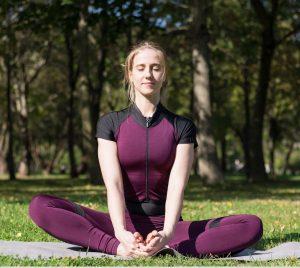By Bernie Clark, July 9th, 2021

Close your eyes and touch the tip of your nose. Congratulations! You have good proprioception. Now, keep your eyes closed and feel the tip of your nose without touching it. That requires a different ability, the ability to sense your body’s inner state rather than its position. This is called interoception and it has been linked to the way we think, our emotions, how we make decisions, our mental health and even our sense of self. Our body is constantly sending signals to the brain and the brain is constantly reacting to our body. Most of this communication happens unconsciously, but many people are consciously attuned to these signals. This ability can lead to many of the benefits attributed to meditation practices: managing stress, regulating emotion, and obtaining insights about the body, mind and emotional state. And, the good news is that interoception can be trained and developed.
There are many forms of perception beyond the traditional five of seeing, hearing, smelling, tasting and touching. Senses are complex and important. They are how we know about the world, but not just the world outside our body. Our senses also tell us what is happening at the boundary between our body and the rest of the universe as well as what is happening inside our body. Proprioception is the term used to describe knowing where we are in space and the position of our parts relative to each other. Interoception is how the brain keeps track of what is happening inside the body.
Defining Interoception
How do you know if you are dehydrated? You feel thirsty! That is interoception. Hungry, sleepy, stiff, aroused… whenever you become aware of an inner state, your interoception is operating. Eighty percent of the fibers of the vagus nerves are sending information to the brain and only 20% of the fibers are bringing instructions from the brain to the organs. As a fetus, before our brain is fully operational, our heart and gastrointestinal tract are already electrically active. The brain develops in response to the organs, not in command of them.[1] Our emotions are embodied: our brain responds to the body and interprets the signals as a particular emotion, but the genesis is somatic. Our brain does not create our emotions but helps us to become aware of them. Bringing this process into consciousness allows us to moderate our responses and re-interpret the signals.
Can you detect your heart beating? Heart beat detection is an interoceptive skill. Not everyone has this ability, especially when you are resting comfortably and your heart rate is slow. But suppose you knocked on a door and are about to walk into a party. Before the door opens you notice your heart is beating faster. This is interoception: you have become aware of your inner state. Now, what does this inner state mean to you? Are you becoming anxious? That can stimulate many negative thoughts about the party. Perhaps you have a strong urge to leave before the door opens. Or does your heart rate indicate excitement? Perhaps you believe that you are about to have a great time and you can’t wait for the door to open. With attention to the signals your body is sending your brain, you can decide which interpretation to make about these signals. But first, you have to be aware of your inner state.
Building Interoception
In the 1980s Cynthia Price developed a style of psychotherapy called Mindful Awareness in Body-Oriented Therapy, or MABT.[2] The therapy is based on the realization that attention to our body changes the experience we are having and our perception of the body, which in turn changes us. We can only have a self if the self has something to perceive. There is a connection between interoception and regulating emotions. People suffering from chronic stress, pain or trauma often have stopped attending to their body’s signals, which makes it difficult to regulate their emotional responses. MABT develops interoceptive awareness by identifying, accessing and appraising internal bodily signals. This leads to an increased ability to understand, express and manage emotions.
MABT builds body literacy, which is the ability to identify and describe sensory experiences. This allows us to link sensation to its cause in one direction (the environment) and our reaction to it in the other direction (our mind). A therapist or teacher may ask a client or student to notice their response to an environmental factor. They then identify and describe what they have noticed, both the physical sensations and any emotional reaction to the sensation.
MABT employs several interoceptive awareness exercises. They include monitoring of the breath, conscious relaxation and softening of the body, and guiding attention to places within the body. While this can be done in a clinical setting, it is also done during meditation practice, tai chi and yoga.[3] Yin Yoga in particular is an excellent practice for developing interoception due to both the time provided to linger in a posture and the variety of bodily sensations that develop.
Using Yin Yoga to Develop Interoception

Sit in a version of the long-legged Butterfly Pose that is appropriate for you (see figure 2). Use blocks under the knees if necessary. How well you do the pose is totally irrelevant. What is important are the sensations that you experience while in the pose. Focus on those sensations.
-
- Start with attending to your breath. Notice what it feels like to breathe. There are many places where you can put your awareness: on the sensation of air flowing through your nostrils, on the movement of your shoulders, chest or belly, on the feeling of expansion and sitting taller on the inhalation and letting go of tension on the exhalation. Choose the sensation that is the most obvious to you, and for two minutes, keep returning your awareness to this sensation. Notice how it changes throughout the cycle of the breath. Breath is always happening naturally; you do not have to create any specific sensation or breathe in any particular way, simply notice what happens as you happen to breathe.
- Next, allow your attention to go to wherever you feel the most muscular tension. As you keep your awareness there, notice what this tension feels like. Look closer: is the tension deep or superficial? Is it in one spot or spread out? How strong or weak is it? Join your awareness of this tension to the breath and notice how the tension ebbs with each exhalation.
- Now, choose a region of your body where the posture feels most challenging. Perhaps it is your hips or one knee. Wherever this area is, guide your awareness to this place and describe the sensations to yourself. Where exactly is the sensation? Again, is it in one place or spread out? Is it deep or shallow? Does it have a shape to it? Is it hot, warm or cool? Is there a temporal quality to it: does it come and go, or is it constant? Does it move around? Notice everything there is to observe about the sensation. Sustain this awareness: if your mind wanders, gently guide your awareness back. With sustained awareness, go deeper. See more and more of the details.
- Finally, notice your innermost feelings. Is there a particular emotion associated with the physical sensation you are experiencing? Is it uncomfortable or challenging? Are there any urges arising because of these feelings? Do you sense a desire to move or change your posture? Is this a good idea, or is it better to stay where you are a bit longer?
- When you decide it is time to come out of the posture, slowly do so. Lean back on your hands, straighten your legs and lie down for a few moments. Savor the memory of the pose and enjoy the rebound. Since this feels so good, attend to this sensation as well.
Our inner sensations are not always constant. They shift, move around and change their nature. Noticing and commenting on these changes, even if quietly to yourself, is part of building your body literacy and developing interoception.
Our body talks constantly and, even if we are not consciously aware of the chatter, the interoceptive messages affect us and can change our psychological state. However, when we are consciously aware of the interoceptive signals, they have a greater ability to affect our thoughts, emotions, judgments and ultimately our behavior.
A Note of Caution
Interoception is the ability to notice, identify, understand and respond appropriately to internal signals. This ability is advantageous in dealing with the challenges of life and accommodating them. However, not for everybody. Just as meditation is not an appropriate tool for all people or in all situations, a heightened interoception can have negative consequences for some people. When awareness is focused inside the body, a few people experience uncomfortable sensations or emotions that they need to repress. For them, increasing interoception may be distressing and problematic. They may not be ready for this experience. In these cases, a teacher or therapist with appropriate mental health training and skills is advised.[4]
Fortunately, for the majority of people, improving interoception, whether through therapy, meditation or yoga, can help improve pain tolerance, equanimity, emotional regulation and decision-making and solidify the sense of self.[5] What we are experiencing is not who we are. We can change the perception that we are “being” an experience to we are “having” an experience.[6] The senses within the body are just as important as the senses that take us outside the body. Yoga is one way to develop and hone our inner sense: our interoception. Yinsters might add that Yin Yoga is a great way to go yinside.
_________________________
[1] Kim Armstrong, “Interoception: How We Understand Our Body’s Inner Sensations,” Observer, September 25, 2019, https://www.psychologicalscience.org/observer/interoception-how-we-understand-our-bodys-inner-sensations.
[2] Cynthia J. Price and Carole Hooven, “Interoceptive Awareness Skills for Emotion Regulation: Theory and Approach of Mindful Awareness in Body-Oriented Therapy (MABT),” Frontiers in Psychology 9 (2018).
[3] J. Gibson, “Mindfulness, Interoception, and the Body: A Contemporary Perspective,” Frontiers in Psychology 10 (2019): 2012, doi: 10.3389/fpsyg.2019.02012. PMID: 31572256; PMCID: PMC6753170.
[4] Gibson, “Mindfulness, Interoception, and the Body.”
[5] L. Schmalzl, C. Powers, A. P. Zanesco, N. Yetz, E. J. Groessl, and C. D. Saron, “The effect of movement-focused and breath-focused yoga practice on stress parameters and sustained attention: A randomized controlled pilot study,” Conscious. Cogn. 65 (2018): 109–125, doi: 10.1016/j.concog.2018.07.012; C. Villemure, M. Ceko, V. A. Cotton, and M. C. Bushnell, “Insular cortex mediates increased pain tolerance in yoga practitioners,” Cereb. Cortex 24 (2014): 2732–2740, doi: 10.1093/cercor/bht124.
[6] Price and Hooven, “Interoceptive Awareness Skills for Emotion Regulation.”
